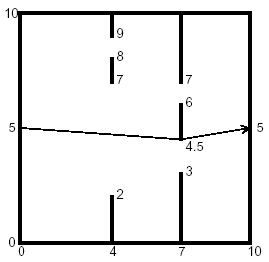POJ_1556_The Doors_判断线段相交+最短路
Description
You are to find the length of the shortest path through a chamber containing obstructing walls. The chamber will always have sides at x = 0, x = 10, y = 0, and y = 10. The initial and final points of the path are always (0, 5) and (10, 5). There will also be from 0 to 18 vertical walls inside the chamber, each with two doorways. The figure below illustrates such a chamber and also shows the path of minimal length.


Input
The input data for the illustrated chamber would appear as follows.
2
4 2 7 8 9
7 3 4.5 6 7
The first line contains the number of interior walls. Then there is a line for each such wall, containing five real numbers. The first number is the x coordinate of the wall (0 < x < 10), and the remaining four are the y coordinates of the ends of the doorways in that wall. The x coordinates of the walls are in increasing order, and within each line the y coordinates are in increasing order. The input file will contain at least one such set of data. The end of the data comes when the number of walls is -1.
2
4 2 7 8 9
7 3 4.5 6 7
The first line contains the number of interior walls. Then there is a line for each such wall, containing five real numbers. The first number is the x coordinate of the wall (0 < x < 10), and the remaining four are the y coordinates of the ends of the doorways in that wall. The x coordinates of the walls are in increasing order, and within each line the y coordinates are in increasing order. The input file will contain at least one such set of data. The end of the data comes when the number of walls is -1.
Output
The
output should contain one line of output for each chamber. The line
should contain the minimal path length rounded to two decimal places
past the decimal point, and always showing the two decimal places past
the decimal point. The line should contain no blanks.
Sample Input
1
5 4 6 7 8
2
4 2 7 8 9
7 3 4.5 6 7
-1
Sample Output
10.00
10.06
你要通过一个包含阻碍墙的房间来找到最短路径的长度。
在x=0,x=10,y=0,y=10时,总会有边。路径的初始和终点总是(0,5)和(10,5),也会有从0到18的垂直墙,每一个都有两道门。
输出应该包含每个房间的一行输出。这一行应该包含小数点后两位小数的最小路径长度,并且总是显示小数点后两位小数。这条线不应该有空格。
把所有点拿出来连边建图,判断一下中间是否有挡住的墙壁即可。
这里的线段判断相交用的方法很菜:判断两直线交点在不在线段上。
因为有除法误差可能比较大。
代码:
#include <stdio.h>
#include <string.h>
#include <algorithm>
#include <queue>
#include <math.h>
using namespace std;
typedef double f2;
#define N 10050
#define eps 1e-6
int head[N],to[N],nxt[N],cnt,n,vis[N],tot,S,T,ghj;
f2 val[N],dis[N];
priority_queue<pair<f2,int> >q;
//********************************************
struct Point {
f2 x,y;
Point() {}
Point(f2 x_,f2 y_) :
x(x_),y(y_) {}
Point operator + (const Point &p) const {return Point(x+p.x,y+p.y);}
Point operator - (const Point &p) const {return Point(x-p.x,y-p.y);}
Point operator * (f2 rate) const {return Point(x*rate,y*rate);}
};
f2 dot(const Point &p1,const Point &p2) {return p1.x*p2.x+p1.y*p2.y;}
f2 cross(const Point &p1,const Point &p2) {return p1.x*p2.y-p1.y*p2.x;}
Point a[N];
typedef Point Vector;
struct Line {
Point p;Vector v;
Line() {}
Line(const Point &p_,const Vector &v_) :
p(p_),v(v_) {}
};
Line b[N];
Point get_point(const Line &l1,const Line &l2) {
Vector u=l1.p-l2.p;
f2 t=cross(l2.v,u)/cross(l1.v,l2.v);
return l1.p+l1.v*t;
}
bool judge(const Point &p1,const Point &p2,const Line &l) {
if(l.p.x<p1.x+eps||l.p.x>p2.x-eps) return 0;
Line l1=Line(p1,p2-p1),l2=Line(l.p,l.v-l.p);
Point p3=get_point(l1,l2);
return p3.x>p1.x&&p3.x<p2.x&&p3.y>l.p.y&&p3.y<l.v.y;
}
//********************************************************
inline void add(int u,int v,f2 w) {
to[++cnt]=v; nxt[cnt]=head[u]; head[u]=cnt; val[cnt]=w;
}
void dij() {
memset(dis,0x7f,sizeof(dis));
memset(vis,0,sizeof(vis));
dis[S]=0;q.push(make_pair(0,S));
while(!q.empty()) {
int x=q.top().second;q.pop();
if(vis[x]) continue;
vis[x]=1;
int i;
for(i=head[x];i;i=nxt[i]) {
if(dis[to[i]]>dis[x]+val[i]) {
dis[to[i]]=dis[x]+val[i];
q.push(make_pair(-dis[to[i]],to[i]));
}
}
}
printf("%.2lf
",dis[T]);
}
void init() {
memset(head,0,sizeof(head)); cnt=0; tot=0; ghj=0;
}
int main() {
while(scanf("%d",&n)&&n!=-1) {
int i,j,k;
init();
f2 x,y,z,w,h;
for(i=1;i<=n;i++) {
scanf("%lf%lf%lf%lf%lf",&x,&y,&z,&w,&h);
a[++tot]=Point(x,y);
b[++ghj]=Line(Point(x,0),a[tot]);
a[++tot]=Point(x,z);
a[++tot]=Point(x,w);
b[++ghj]=Line(a[tot-1],a[tot]);
a[++tot]=Point(x,h);
b[++ghj]=Line(a[tot],Point(x,10));
}
a[++tot]=Point(0,5); S=tot;
a[++tot]=Point(10,5); T=tot;
for(i=1;i<=tot;i++) {
for(j=1;j<=tot;j++) {
if(a[j].x>a[i].x+eps) {
int flg=1;
for(k=1;k<=ghj;k++) {
if(judge(a[i],a[j],b[k])) {
flg=0; break;
}
}
if(flg) {
add(i,j,sqrt((a[i].x-a[j].x)*(a[i].x-a[j].x)+(a[i].y-a[j].y)*(a[i].y-a[j].y)));
//printf("%.2lf
",sqrt((a[i].x-a[j].x)*(a[i].x-a[j].x)+(a[i].y-a[j].y)*(a[i].y-a[j].y)));
}
}
}
}
dij();
}
}